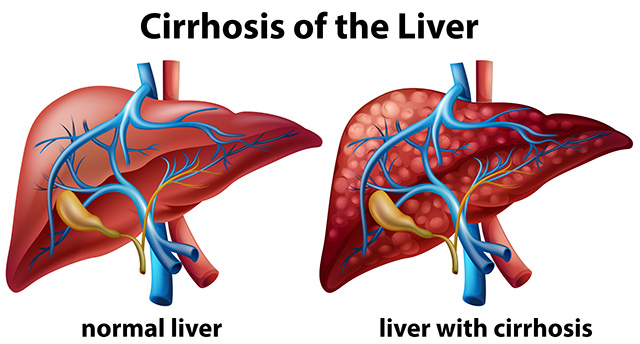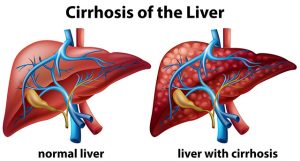
Cirrhosis — causes, side effects and treatments at NaturalPedia.com
Wednesday, February 14, 2018 by Frances Bloomfield
http://www.naturalpedia.com/cirrhosis-causes-side-effects-and-treatments-at-naturalpedia-com.html

Cirrhosis is a condition wherein the liver becomes irreversibly scarred and unable to function properly due to damage. The scars that develop because of this slowly progressing disease block the flow of blood and bile through the liver. A healthy liver is able to regenerate the majority of its cells when it sustains damage. If the damage is too severe or too long-lasting, however, then this leads to fibrosis or the scarring of the liver.
There are a variety of diseases that can cause a person to develop cirrhosis. According to NIDDK.NIH.gov, these are:
- Chronic hepatitis C: This is a viral infection that damages or inflames the liver. A person can acquire chronic hepatitis C by being injected with infected blood or through sexual intercourse.
- Alcohol-related liver disease: Heavy alcohol use over the course of several years can damage the liver. This is one of the most common causes of cirrhosis, particularly in the United States.
- Nonalcoholic fatty liver disease: Fat builds up within the liver and eventually leads to the formation of scar tissue. This can occur in people who are:
- Overweight or obese
- Have high blood pressure
- Have high cholesterol
- Diabetic
- Hepatitis B: This type of hepatitis can be both an acute and chronic disease. Similar to chronic hepatitis C, hepatitis B is transmitted through the exchange of infected bodily fluids.
- Bile duct-damaging or -blocking diseases: Much rarer but just as dangerous, illnesses that block the bile ducts and cause it to accumulate in the liver can increase the risk of cirrhosis. Some of these diseases include:
- Cystic fibrosis: A genetic disorder that primarily affects the lungs, cystic fibrosis can move to the liver and intestine.
- Biliary atresia: A childhood liver disease in which one or more bile ducts are blocked, abnormally narrow, or absent altogether.
Known side effects of cirrhosis
People who are in the earlier stages of cirrhosis normally won’t display any signs that they have the disease. More symptoms will show as the liver gradually becomes weaker. When this happens, the following symptoms are likely to occur:
- Fatigue
- Insomnia
- Itchy skin
- Loss of appetite
- Nausea
- Red palms
- Tenderness where the liver is located
- Visible blood capillaries on the skin of the upper abdomen
- Weakness
As a person becomes more cirrhotic, they will experience any of these symptoms:
- Accelerated heartbeat
- Ascites or abdominal swelling
- Black and tarry or very pale stool
- Bleeding gums
- Edema or swelling of the legs
- Hair loss
- Impotence
- Jaundice or yellowing of the skin, sclera, and tongue
- Memory problems
- Mobility problems
- Nosebleeds
- Spider angiomas or spider-like blood vessels on the skin
Body systems harmed by cirrhosis
In addition to affecting the liver, cirrhosis can give rise to complications that harm other organs and organ systems, such as:
- Hepatic encephalopathy: A cirrhotic liver is unable to remove toxins from the blood. These toxins amass in the bread and result in this disease. Hepatic encephalopathy can cause confusion and memory loss, diminish mental function, and can even lead to coma.
- Gallstones and bile duct stones: This occurs when bile is unable to flow properly through the gallbladder and bile ducts, causing bile to gather and harden.
- Splenomegaly: An abnormal enlargement of the spleen, splenomegaly can make a person more prone to infections and anemia.
Food items or nutrients that may prevent cirrhosis
One way to avoid cirrhosis is to consume foods and drink beverages that are good for the liver. According to HealthLine.com, these foods include:
- Fatty fish: Salmon, tuna, and other fatty fish contain anti-inflammatory omega-3 fatty acids. On top of fighting inflammation, omega-3 fatty acids can prevent fat from building up in the liver and normalize liver enzyme levels.
- Coffee: Just like fatty fish, coffee can decrease liver inflammation. At the same time, it can increase the liver’s antioxidant levels. Moreover, coffee can inhibit the buildup of collagen and fat.
- Cruciferous vegetables: Broccoli, Brussels sprouts, and mustard greens can protect the liver from damage and enhance its natural detoxification capabilities.
- Nuts: Their high nutritional content makes them a good food choice for people who want to avoid cirrhosis, especially those with nonalcoholic fatty liver disease.
Treatments, management plans for cirrhosis
Treating cirrhosis usually involves addressing the underlying health issues that caused it. For example, people whose cirrhosis was caused by alcohol will be told to limit their consumption of alcohol or cut it out of their diets entirely. Many of these people will be recommended alcohol dependency treatment programs by their doctors. Those whose cirrhosis was brought on by hepatitis B or C will be prescribed medication. Liver transplants are reserved for the worst cases.
In addition, there are steps that can be taken to ease the symptoms of cirrhosis. One is to adhere to a low-sodium diet to reduce the risk of edema. Another is to stick to a healthy diet and exercise regularly to maintain a healthy weight and prevent muscle wasting.
Where to learn more
- Curcumin Helps Repair Cirrhosis of the Liver
- Drinking coffee reduces chances of dying from liver cirrhosis
- Study: more people have liver cirrhosis than previously thought
- Top 10 Herbs for Liver Cirrhosis
- What is Liver Cirrhosis? 8 Home Remedies to Cure it Naturally
Summary
Cirrhosis is a progressive liver disease in which scar tissue replaces healthy liver tissue, impairing the function of the liver. Numerous diseases can cause cirrhosis, such as hepatitis B and nonalcoholic fatty liver disease. People with cirrhosis will experience fatigue, jaundice, edema, ascites, and other symptoms. Furthermore, cirrhosis can lead to the development of health complications that affect the brain, gallbladder, and spleen.
Although irreversible, cirrhosis can be prevented and managed through certain lifestyle changes. Cutting down or removing alcohol from the diet, engaging in regular physical activity, and consuming liver-friendly foods can support a healthy liver, decreasing the chances of cirrhosis.
Sources include:
Tagged Under: Tags: cirrhosis






